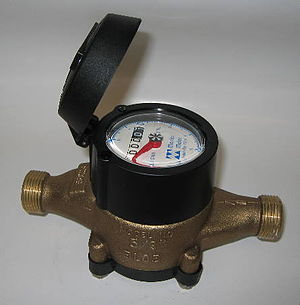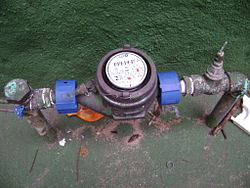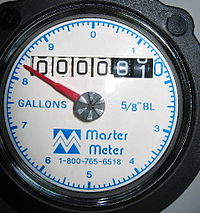- Water meter
-
A water meter is a device used to measure the volume of water usage. This article provides an overview of technical aspects of water meters. The worldwide prevalence of metering as well as its economic benefits and costs are covered in the separate article on water metering.
In many developed countries water meters are used at each residential and commercial building in a public water supply system. Water meters can also be used at the water source, well, or throughout a water system to determine flow through that portion of the system. Water meters typically measure and display total usage in cubic feet (ft.3), cubic meters (m3) or US gallons on a mechanical or electronic register. Some electronic meter registers can display rate-of-flow as well as total usage.
There are several types of water meter in common use. Selection is based on different flow measurement methods, the type of end user, the required flow rates, and accuracy requirements.
In North America, standards for manufacturing of water meters are made by the American Water Works Association.
Contents
Types of meters
There are two major methods of flow measurement in use, displacement and velocity, with sub-technologies within each of them. Common displacement designs include oscillating piston and nutating disk meters. Velocity-based designs include single- and multi-jet meters and turbine meters. There are also non-mechanical designs, for example electromagnetic and ultrasonic meters.
In addition to the more common types of meter, there are meters designed for special uses. Most meters in a typical water distribution system are designed for cold potable water only. There are specialty water meters manufactured for specific other uses. Hot water meters are designed with special materials that can withstand higher temperatures. Meters for reclaimed water have special lavender register covers to signify that the water is non-potable and should not be used for drinking.
Water meters are generally owned, read, and maintained by a public water provider such as a city, rural water association, or private water company. In some cases an owner of a mobile home park, apartment complex or commercial building may be billed by a utility on one meter, and want to share the cost of the bill among the tenants. In this case, private meters may be purchased to separately track usage of each unit in what is called submetering.
Displacement water meters
This type of water meter is most often used in residential and small commercial applications. Displacement meters are commonly referred to as Positive Displacement, or "PD" meters. Two common methods of positive displacement measuring are Oscillating Piston meters and Nutating Disk meters. Either method relies on the water to physically displace the moving measuring element in direct relation to the amount of water that passes through the meter. The piston or disk moves a magnet that drives the register.
PD meters are generally very accurate at low to moderate flow rates typical of residential and small commercial users, and are common in sizes from 5/8" to 2". Because displacement meters rely on all water flowing through the meter to "push" the measuring element, they generally are not practical in large commercial applications requiring high flow rates or low pressure loss. PD meters normally have a built-in strainer to protect the measuring element from rocks or other debris that could stop or break the measuring element. PD meters normally have bronze, brass or plastic bodies with internal measuring chambers made from molded plastics and stainless steel.
Velocity water meters
A velocity-type meter measures the velocity of flow through a meter of a known internal capacity. The speed of the flow can then be converted into volume of flow for usage. There are several types of meters that measure water flow velocity to determine totality usage. They include jet meters (single-jet and multi-jet), turbine meters, propeller meters, and mag meters. Most velocity-based meters have an adjustment vane for calibration of the meter to required accuracy.
Multi-jet meters
Multi-jet meters are very accurate in small sizes and are commonly used in 5/8" to 2" sizes for residential and smaller commercial uses. Multi-jet meters use multiple ports surrounding an internal chamber, to create multiple jets of water against an impeller. The impeller rotation speed is in relation to the velocity of water flow. Multi-jets are very accurate at low flow rates, but are not used in larger sizes, since they don't have the straight-through flow path needed for the high flow rates used in large pipe diameters. Multi-jet meters generally have an internal strainer element that can protect the jet ports from getting clogged. Multi-jet meters normally have bronze alloy bodies or outer casings, with internal measuring parts made from modern thermoplastics and stainless steel.
Turbine meters
Turbine meters are less accurate than displacement and jet meters at low flow rates, but the measuring element does not occupy or severely restrict the entire path of flow. The flow direction is generally straight through the meter, allowing for higher flow rates and less pressure loss than displacement-type meters. They are the meter of choice for large commercial users, fire protection, and as master meters for the water distribution system. Strainers are generally required to be installed in front of the meter to protect the measuring element from gravel or other debris that could enter the water distribution system. Turbine meters are generally available for 1-1/2" to 12" or higher pipe sizes. Turbine meter bodies are commonly made of bronze, cast Iron, or ductile iron. Internal turbine elements can be plastic or non-corrosive metal alloys. they are accurate in normal working conditions to 0.2l/s however are affect greatly with dog mix interference.
- Fire meters are a specialized type of turbine meter with approvals for the high flow rates required in fire protection. They are often approved by Underwriters Laboratories (UL) or Factory Mutual (FM) for use in fire protection.
- Fire hydrant meters are a specialized type of portable turbine meter that are attached to a fire hydrant to measure water out of the hydrant. The meters are normally made of aluminum to be light weight, and are usually 3" capacity. Utilities often require them for measurement of water used in construction, pool filling, or where a permanent meter is not yet installed.
Compound meters
A compound meter is used where high flow rates are necessary, but at times there are smaller rates of flow that still need to be accurately measured. Compound meters have two measuring elements and a check valve to regulate flow between them. At high flow rates, water is normally diverted primarily or completely to the turbine part of the meter. When flow rates drop to where the turbine meter cannot measure accurately, a check valve closes to divert water to a smaller meter that can measure the lower flow rates accurately. The low flow meter is typically a multi-jet or PD meter. By adding the registration of the high and low meter registers, the utility has the total consumption through the meter.
Electromagnetic meters
Magnetic flow meters, commonly referred to as "mag meters", are technically a velocity-type water meter, except that they use electromagnetic properties to determine the water flow velocity, rather than mechanical means which jet and turbine meters use. Mag meters use the physics principle of Faraday's law of induction for measurement, and require AC or DC electricity from line or battery to operate the electromagnets. Since mag meters have no mechanical measuring element, they normally have the advantage of being able to measure flow in either direction, and use electronics for measuring and totalizing the flow. Mag meters can also be useful for measuring untreated water, raw (untreated/unfiltered) water, and wastewater, since there is no mechanical measuring element to get clogged or damaged by debris flowing through the meter. Strainers are not required with mag meters, since there is no measuring element in the stream of flow that could be damaged. Stray electrical energy flowing through the flow tube can cause inaccurate readings, therefore most mag meters are installed with either grounding rings or grounding electrodes to divert stray electricity away from the electrodes inside the flow tube which are used to measure the flow.
Ultrasonic meters
Ultrasonic water meters use an ultrasonic transducer to send ultrasonic sound waves through the fluid to determine the velocity and translate the velocity into measurement of the water volume.
Registers
There are several types of registers on water meters. A standard register normally has a dial similar to a clock, with gradations around the perimeter to indicate water usage measured by the meter, as well as a set of odometer wheels similar to that in a car. Modern registers are normally driven by a magnetic coupling between a magnet in the measuring chamber attached to the measuring element, and another attached to the bottom of the register. Gears in the register convert the motion of the measuring element to the proper usage increment for display on the sweep hand and the odometer. Many registers also have a leak detector. This is a small visible disk or hand that is geared closer to the rotation speed of the drive magnet, so that very small flows that would be visually undetectable on the regular sweep hand can be seen.
With Automatic Meter Reading, manufacturers have developed pulse or encoder registers to produce electronic output for radio transmitters, reading storage devices, and data logging devices. Pulse meters send a digital or analog electronic pulse to a recording device. Encoder registers have an electronic means for an external device to interrogate the register for either the position of the odometer wheels or a stored electronic reading. Frequent transmissions of consumption can be used to give smart meter functionality.
There are also some specialized types of registers such as LCD display instead of mechanical odometers, and registers to output data or pulses to a variety of recording and controller devices. For industrial applications, output is often 4-20 mA analog, for the recording or control of different flow rates in addition to totalization.
Water meter reading
Different size meters may indicate a reading in different resolutions. One rotation of the sweep hand may be 10 gallons or 1000 gallons (1 to 100 ft.3, 0.1 to 10 m3). If one rotation of the hand represents 10 gallons, the meter has a 10 gallon sweep. sometimes the last number(s) of the odometer are non-rotating or printed on the dial face. The fixed zero number(s) are represented by the position of the rotating sweep hand. If one rotation of the hand is 10 gallons, the sweep hand is on 7, and the odometer shows 123456 plus a fixed zero, the actual total usage would be 1,234,567 gallons. A moving odometer wheel that has not completely turned over is counted as the lower number.
In the United States most utilities bill only to the nearest 100 or 1000 gallons (10 to 100 ft.3, 1 to 10 m3), and often only read the leftmost 4 or 5 numbers on the odometer. They would only read and bill using 1234 and rounding to 1,234,000 gallons based on a 1000 gallon billing resolution and the example above. The most common rounding for a particular size meter will often have different colored number wheels, the ones ignored being black, and the ones used for billing being white.
See also
- Automatic Meter Reading
- Advanced Metering Infrastructure
- Meter Data Management
- Flow measurement
- Water metering
- Public utility
- Drinking water
- American Water Works Association
- Gas meter
- Electric meter
- Universal Metering Interface (UMI)
- Utility submetering
References
- American Water Works Association Manual of Water Supply Practices Manual M6, Water Meters — Selection, Installation, Testing, and Maintenance, ISBN 1-58321-017-2
- American Water Works Association standards C700-02: Cold-Water Meters—Displacement Type, Bronze Main Case
- American Water Works Association standards C701-02: Cold-Water Meters—Turbine Type
- American Water Works Association standards C702-01: Cold-Water Meters—Compound Type
- American Water Works Association standards C703-96: Cold-Water Meters—Fire Service Type
- American Water Works Association standards C707-05: Encoder-Type Remote-Registration Systems for Cold-Water Meters
- American Water Works Association standards C708-05: Cold-Water Meters Multijet Type
External links
- Water Measurement Manual of the United States Bureau of Reclamation
- Utilimetrics - Non-profit industry trade association (Formerly known as the Automatic Meter Reading Association AMRA)
- How to read different size water meters (PDF file)
- How Meter Keeps Tab On The Water You Use, Popular Science, July 1950 very detailed article with good illustrations
Categories:- Flow meters
- Water technology
- Public services
- Water industry
Wikimedia Foundation. 2010.




